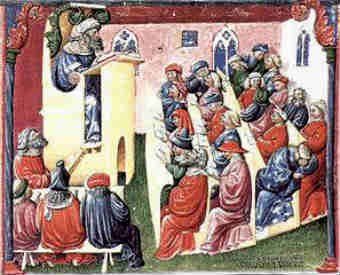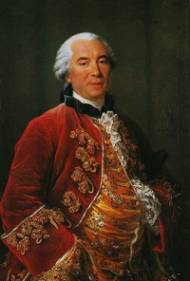On the Origins of New Forms of Life
1.3: Hybrids and Immutability
(Continued from the previous page)
 The schoolmen took their worldview from Aristotle, not from observation. (Artist: Laurentius de Voltolina)
The schoolmen took their worldview from Aristotle, not from observation. (Artist: Laurentius de Voltolina)
Although many religious people still claim "species" are eternal and unchanging, no such idea is expressed in the Bible. It says only that animals and plants were created "in the Beginning," not that they remained the same thereafter. Modern religious thinkers who adhere to the notion of immutability obtained it from the schoolmen, who in their turn, took it from Aristotle, a pagan, who did make such a claim (On the Generation of Animals, fourth century BCE):
The scholastic philosophers adhered to this notion of immutability, just as they did to most other things Aristotle said. Thus, Aquinas, the greatest of the schoolmen, confirms the idea of immutability:
The assumption that there truly were "natural species," immutably established by the "Author of Nature," continued to hold sway on into the scientific era. Thus, in his Essay toward a Natural History of the Earth (1695), which is as much religious diatribe as natural history, John Woodward boasts
 Woodward
Woodward1665-1728
Often, in connection with such assertions, it was claimed that God, or a personified Nature viewed as a sentient force, had made hybrids sterile in order to prevent the various types that made up the divine creation from blending together. The marriage of these two claims — though both were unsubstantiated by observation (see discussion of hybridization in next section) — is encountered again and again in the writings of a broad range of authors of the early scientific period. Thus, Oliver Goldsmith in his preface to Brooke's Natural History (1763: 251) assures his readers that hybrids can never disrupt the natural order:
 Goldsmith
Goldsmith1728-1774
 Rousseau
Rousseau1712–1778
Jean-Jacques Rousseau (Émile, The Creed of a Savoyard Priest, 1762) gives his readers a similar account of Dame Nature's plan:
In the 1700s, many considered not only animal hybrids, but even plant hybrids, widely taken for granted today, as unnatural. For example, Chambers Cyclopedia of English Literature (1727-1741) listed the following definition: "Mules, among gardeners, denote a sort of vegetable monsters, produced by putting the farina fæcundans [i.e., pollen] of one species of plant into the pistil or utricle of the other."⁶ Zirkle (1935: 1) notes that
This notion that nature proscribed hybrid animals and plants to preserve the natural order is of ancient origin. The Roman poet Lucretius (On the Nature of Things, V, first century BCE) gave clear expression to the idea:
In Latin, the word hybrida was applied not only to hybrid animals and plants, but also to anything that violated natural law. Thus, Lewis and Short (Latin Dictionary) give the following definition of the word from which our hybrid is derived: "unbridled, lawless, unnatural; hence, of animals produced from two different species, a mongrel, hybrid." In the same place, they note hybrida is probably kindred to hubris (ὕβρις), used by the ancient Greeks to designate any violation of the natural order, especially one involving sexual matters.⁸ Apparently, hybrids fell under the heading of hubris because hybrids resulted from a form of sexual contact deemed to breach that order.⁹ There was a religious significance attached to such matters since the Greeks believed acts of hubris brought down the curse of the gods.
Jews, too, from an early date viewed hybrids as a desecration of a natural order laid down by God. Writing in the first century CE, the Jewish scholar Philo Judaeus (The Special Laws, III, 46) asserts that
Many even in the modern era have expressed this idea that God abhors transgressions of natural law. For example, in his Notes on the Miracles of Our Lord (1846), Anglican Archbishop Richard Chevenix Trench comments that "the unnatural, the contrary to order, is of itself ungodly."10 Such ideas are even widened at times to encompass not only hybrid animals and plants, but also hybridity of a purely abstract and non-biological nature. For example, an early film critic, Victor Oscar Freeburg claimed lasting art can never result when media are mixed:
 Buffon
Buffon1707-1788
It must be said, however, that throughout much of the history of science there have been those who rejected the claim that hybrids are unnatural and consistently sterile. In his Histoire naturelle, the great naturalist Comte Georges-Louis Leclerc de Buffon (1707-1788) expressed his (correct) opinion that hybrids vary in fertility depending on the cross from which they are derived: "In mixed species, that is to say in those animals that, like the mule, come from two different species, there are, as in the pure species, different degrees of fertility."¹² Another early example is the botanist Christian Julius Wilhelm Schiede, who in 1825 wrote an entire book on the subject of hybrid plants occurring naturally in Germany and Italy.¹³
NEXT PAGE >>
2. First Part, Question 98, Art. 1; Hutchins (1952a: 517
3. Woodward (1695: 246-247).
4. Goldsmith (1763).
5.Rousseau (1928).
6.Quoted (s.v. mule) in the Oxford English Dictionary.
7.Hutchins (1952h: 73).
8.The word hybrida appears in Latin in the sense of a cross-bred human being by the end of the Roman Republic (prior to 50 BCE). Thus, Julius Caesar (Bellum Africum, 19.3) used hybrida to describe half-breed soldiers in an opposing army. A decade later, in his satires (I.7.2), Horace (30 BCE) also uses hybrida in this sense. Some scholars have suggested hybrida was originally used in Latin in the narrow sense of hybrids between tame and feral pigs (see OED, s.v. hybrid), but this argument is based on usages in Pliny the Elder, and later authors dating a century or more after those just cited. The restriction in sense therefore is probably unwarranted. For a detailed discussion of this topic see Warren (1884). The Romans introduced the letter y during the late Republic to transliterate Greek υ into Latin (Wheelock 1963: xxxi). Apparently, the ς of υβρις became the d of hybrida because the transliteration was based on a declined form of υβρις such as υβριδος (accusative singular). The substitution of the common Latin feminine ending -a completed the transition.
9.Encyclopedia Britannica (1967: vol. XI, 921).
10.Trench (1846: 15).
11.Freeburg (1918: 166).
12.Cuvier et al., eds., (1839–1844: vol. IV, 4462). Translated by E. M. McCarthy. Original French: "Dans les espèces mixtes, c'est-à-dire dans celles des animaux qui, comme le mulet, proviennent de deux espèces différentes, il y a, comme dans les espèces pures, des degrés différents de fécondité ou plutót d'infécondité."
13.Schiede (1825). Lasch (1829) also listed naturally occurring hybrids.
Most shared on Macroevolution.net:
Human Origins: Are we hybrids?
On the Origins of New Forms of Life
Mammalian Hybrids
Cat-rabbit Hybrids: Fact or fiction?
Famous Biologists
Dog-cow Hybrids
Georges Cuvier: A Biography
Prothero: A Rebuttal
Branches of Biology
Dog-fox Hybrids